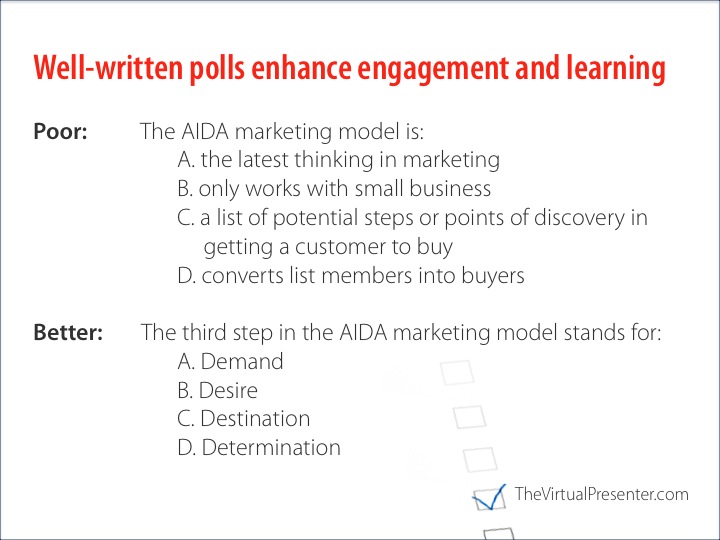Engage with more brain-friendly polls for webinars and virtual class sessions
Part 1 of a 3-part series
Web conferencing solutions are flush with tools that help you really connect with an audience you can’t see. Polls – web conferencing’s version of a multiple choice question – are among the most popular.
What tools don’t teach you, though, are the skills to use them well. It is skills that separate great presenters and facilitators from the ones we otherwise put on speakerphone while getting caught up on email.
What follows is not an exhaustive academic treatment of writing multiple-choice questions, but it should jumpstart how you add some immediate impact to your use of polls. (Click on the graphic below to better see the example.)
Write the “stem” so it could be answered without the choices
In official lingo, the stem is the question or statement that leads up to the multiple choices. I hope it goes without saying that is should be focus on only one clearly formulated problem. Write the “stem” so it could be answered without the choices
Take Action:
 Test your question by covering up the answers. Could the poll-taker understand and answer the question?
Test your question by covering up the answers. Could the poll-taker understand and answer the question?
Put most of the wording in the stem
Your objective should be to minimize how many times the attendee or learner has to read each item.
Take Action:
Shoot to make it easy for them to read the stem (the first part of the question before the answers) once and the answers as few times as possible.
Keep all options parallel and grammatically consistent
Inconsistency makes the brain work harder. We do want attendees or learners to have to think (is critical for engagement and learning), but we don’t want them churning brain cycles figuring out something that’s poorly written.
Take Action:
Brush up using this great reminder of parallel structure.
Write answers so they don’t unintentionally give away clues to the correct answer
Is the length of the correct answer in proportion? Is there a verbal or idiomatic clue that relates the answer to the stem? Are the “distractors” (wrong answers) plausible? Are the answers in an order that may give something away?
Take Action:
- Vary the length of all the answers or make them all about the same.
- Make sure there isn’t a word association that gives it away.
- Stimulate thought by ensuring the distractors are reasonably logical choices.
- Arrange the answers in alphabetical or numerical order.
The bottom line
The skill of writing better multiple choice questions is useful, obviously, beyond poll in webinars, webcasts, and virtual classes. What’s a little extra fun is that now on you’ll notice poorly written poll questions everywhere. Even if they don’t know, you do.
And it’s the little things that make big differences.
Welcome to The Grammar Geek Club.

Mike Schwartz
Hi Roger,
These are good suggestions for creating more meaningful poll questions.
But as a frequent webinar attendee I think one other point also should be considered by the webinar host when developing poll questions, and that is relevance.
More often than not webinar hosts mindlessly pepper their webinar with polls because they know they should add a dose of ‘interaction’ to the event. So those of us in the audience are so desperate for some type of interaction that we jump at the chance to ‘do something’.
But after the poll results come in the host normally just recites the results, which all of us can see anyway.
What’s missing is context or relevance of the results. Are the results unexpected? Do they follow trends? How does this polling information link back to the webinar content or any of the points the host is trying to make?
So I think crafting better poll questions is a great step in the right direction, but without relevance they’re still useless from an audience point of view.
Mike
TheVP
Hey Mike, thanks for reaching out. You are SO right.
I haven’t written about it for awhile, but I spoke about it just two days ago. In fact, I went so far as to say that if your poll (or any other form of interaction) isn’t germane to the dialogue on the the topic, it’s shameful. You’re wasting the time of everybody in the room.
Stay tuned. What I didn’t say in this post were several things, including that this is part one of two or three (so I didn’t have a 2000-word blog post).
LOVE that you’re not one of the “push a poll to be interactive” voices I often rail against. Thanks for carrying the torch.
-R